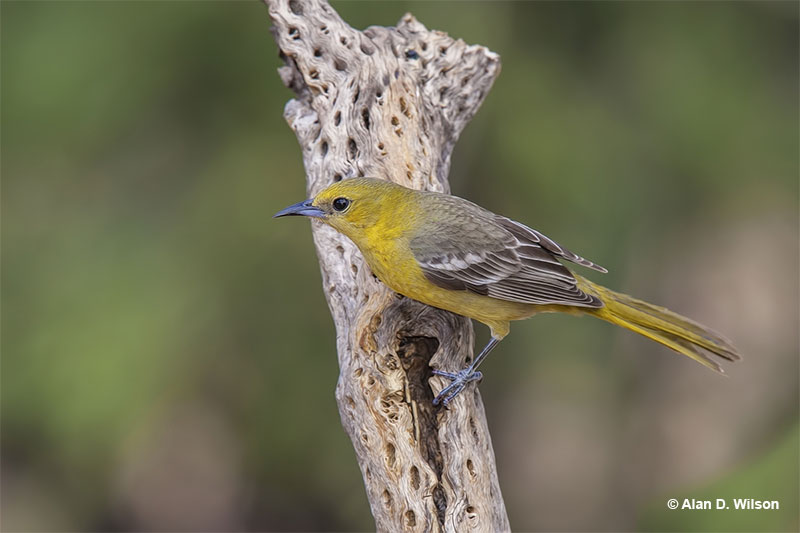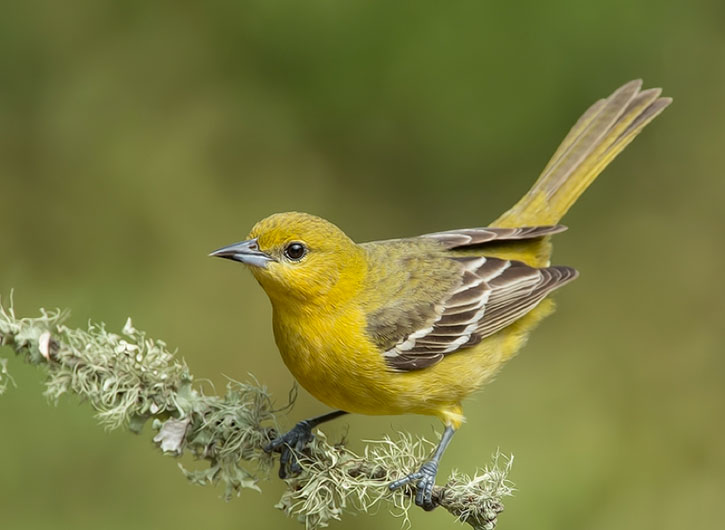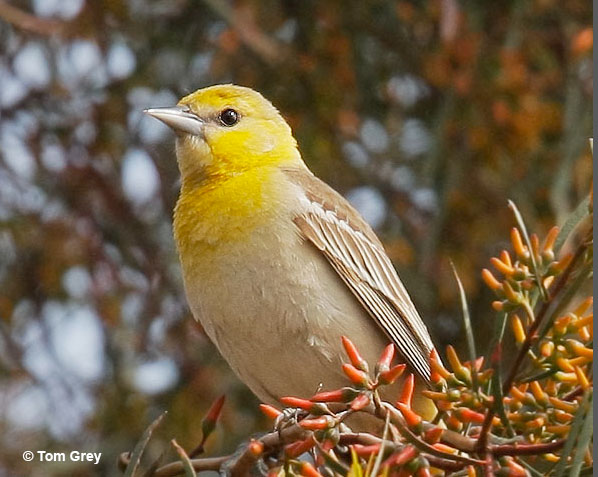
The female oriole plays a crucial role in the lifecycle of these colorful species, with responsibilities that range from building the nest and laying eggs to incubating the clutch and caring for the young.
While male orioles are known for their striking plumage and territorial behavior, female orioles often exhibit a quieter presence.
Here is everything you need to know about how to differentiate between female and male orioles!
On this page
Female vs Male Oriole
New World orioles are a diverse family of birds found throughout the Americas, with 33 species in total.
Of these, ten can be seen in North America with the most common ones including Baltimore Oriole, Bullock’s Oriole, Scott’s Oriole, and Orchard Oriole. All of them are remarkably similar in plumage colors and behavior, which is why we can present such generalized distinctions between males and females.
One of the most striking differences between male and female orioles is their appearance. Males are typically black and vibrant yellow or orange with white markings, making them highly visible and easy to spot. In contrast, females are much duller in color, sporting olive-green, yellowish, and orangish hues contrasted by dull dark grays.

Female Orchard Oriole. Photograph © Alan Wilson.
Behaviorally, male and female orioles also differ in several important ways. Males are highly territorial and aggressive toward other males and intruders, whereas females are more aggressive toward other females.
Females are also quieter than males, using shorter and simpler songs to communicate with their mates. Females are primarily responsible for building the nest, incubating the eggs, and brooding the young, while males assist with feeding.
Scientific information
| FEMALE ORIOLE | MALE ORIOLE | |
| SIZE | Smaller and lighter.
On average, about an inch shorter than the male. |
Larger and heavier.
|
| APPEARANCE | Duller and more inconspicuous. | More colorful.
|
| PLUMAGE | Typically in shades of dull olive-green, yellow, and orange contrasted by dull dark gray. | Two main colors: black and yellow or orange. White markings on wings.
|
| BEHAVIOR | Builds the nest, incubates eggs, and broods the young.
Aggressive towards other females. |
Elaborate courtship displays.
Aggressive towards other males and intruders.
|
| SOUNDS | Quieter, sing less frequently.
Songs are shorter and less complex. |
Louder and more vocal.
Songs are complex. |
Duller Plumage
One of the most notable differences between male and female orioles is their plumage, with males typically being much more noticeable and colorful than females.
Males are typically black and vibrant yellow or orange with white markings, making them highly visible and easy to spot. This bright and striking coloration is thought to play a role in attracting mates and establishing territory.

Female Bullock’s Oriole
In contrast, females are much duller in color, sporting a range of muted hues such as olive greens, dull yellows, dull oranges, and dull dark grays.
One possibility is that it helps to camouflage them when they are sitting on the nest, making them less visible to predators. Another possibility is that it helps them to avoid the attention of aggressive males, who may be more likely to attack other males or brightly colored females.
Behavior
Male and female orioles are known to exhibit different behavior, including different vocalizations and reproductive behavior. These differences can be attributed to the distinct roles that each gender plays in the life cycle of the species.
One of the most notable differences between male and female orioles is their vocalizations. Male orioles are known for their complex songs, which they use to establish and defend their territory.
In contrast, female orioles are much quieter, and their songs are shorter and less complex. They use short calls to communicate from the nest.
In terms of reproductive behavior, male and female orioles also behave quite differently.
Males engage in elaborate courtship displays to attract females, including fluffing up their feathers, bowing, and singing. They can also be aggressive towards other males and intruders who attempt to enter their territory.
Females, on the other hand, are more likely to be aggressive toward other females. Female birds are responsible for building the nest, incubating the eggs, and brooding the young, while males help with feeding.
How to Tell a Younger Oriole’s Gender
It can be challenging to identify the gender of a young oriole because its plumage is not fully developed. However, there are a few subtle differences that can be used to make an educated guess.
In general, juveniles look similar to females. Young male orioles tend to have slightly brighter and more vibrant plumage than females and may have markings and plumage patterns that are only exhibited by males.
Female juvenile orioles look very much like adult females, only that they may be even duller in coloration and look a bit ruffled.
However, these differences can be quite subtle.

Juvenile Orioles look similar to female Orioles. This is a young Baltimore Oriole. Photograph © Elaine R. Wilson
Lifecycle of a Female Oriole
Orioles typically breed once or twice per year, with the exact timing depending on the species and environmental factors. Clutches usually consist of 3-7 eggs, with the exact number depending on the species. The eggs are usually whitish to grayish to very pale blue in color, with speckling that helps to camouflage them in the nest.
The female incubates the eggs for around 11-14 days. After hatching, the young orioles spend around 11-14 days in the nest, being fed and cared for by their parents.
On average, young orioles reach independence around two weeks after fledging.
The lifespan of orioles varies depending on the species and environmental factors, but on average, they live for around 6-10 years in the wild.
Frequently Asked Questions
What is a female oriole called?
As with other female birds, female orioles can be called hens. In general, female orioles can just be called females.
How can you tell the difference between male and female orioles?
Male orioles typically have striking black and vibrant yellow or orange plumage with white markings, while female orioles are generally duller. In addition to their appearance, male and female orioles also exhibit different behaviors, with males being territorial and aggressive toward other males and intruders, while females are often quieter and more focused on nesting and caring for their young.
What color is a female oriole?
Female orioles are a duller version of the male of its species, sporting olive-green, dull yellow, dull orange, and dull dark grays.
Conclusions
In conclusion, female orioles play a vital role in the life cycle of these colorful songbirds, from building the nest and laying eggs to incubating and caring for the young.
The differences between male and female orioles can be observed in their appearance, behavior, and vocalizations.
While male orioles have strikingly bright plumage, sing complex songs, and are more aggressive, then females have duller colors, shorter and simpler songs, and focus more on caring for the young.
